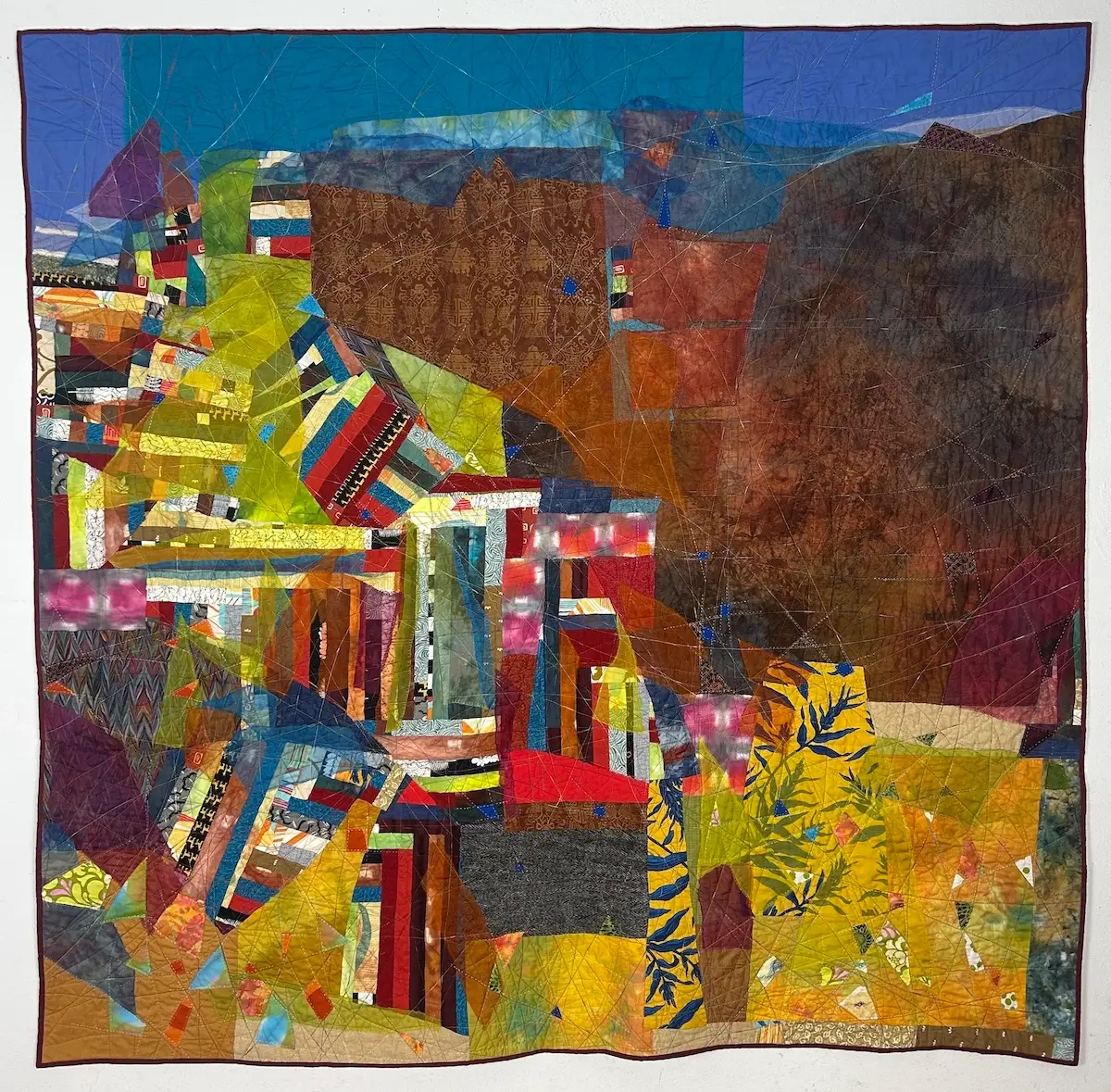Kathy Ford creates quilts that are layered with story, structure, and heart. With roots in architecture and a deep commitment to reuse and care, she creates textile art that holds memory, meaning, and discovery in every stitch.

Tell us more about how your quilt making journey began.
I was twenty-two, just graduated from college and working in an architecture firm in NYC while applying to graduate school. One Saturday afternoon I felt the urge to randomly piece odd bits of fabric together like a crazy quilt.
I didn’t have any fabric and thread. Instead, I used the drafting tools of my trade and followed a few simple, arbitrarily chosen rules to draw six blocks of twenty pieces each onto square pieces of paper. Not only was there no logic to the placement of the shapes in each block drawing, I had no preconception about what to do with them or how they would be put together.
I was unaware that the abstractness of this endeavor of drawing lines on paper was leading me away from the actual experience of making something as visceral and tactile as a crazy quilt.
Eleven years later, following the birth of my first child, I unearthed these tracings along with scraps of fabric kept from clothes I’d made as a teenager, bought a few new pieces of fabric, and devised a way to make my first ‘ordered’ crazy quilt.
As an Amazon Associate I earn from qualifying purchases. Read more about our affiliate linking policy.

If one of your quilts could speak, what story would it tell about you?
I began my third quilt in 1992, the year my daughter turned two and I became pregnant again. Still working within a tradition of making blocks that would come together with sashing, I was able to complete the sixteen large square blocks destined to form a queen-size quilt.
My son Ben was born with Down syndrome. From that moment on, all the spaces in my life that had served as connective tissue supporting all that I thought I was, simply become something different.
When I was finally drawn to complete the queen-size top, I started thinking about how thinner spaces of sashing could take on the quality of a centerpiece instead of the arrangement of blocks having precedence.
What kind of pattern or figure could complement the character of the diagonal created in the clipped squares of each block? How many layers of order could be built into the smaller spaces of the sashing? Would a reversal of “special” and “normal” be apparent?
Riding the surge of energy following Ben’s birth, I was able to finish sewing the quilt top together within a few weeks. The quilt was basted and hand quilting begun.
For the next seven years, this quilt held the energy of a profound change that moving through life with this special child entailed. It lived in a hoop that moved around our NYC loft with me, to our bungalow in Catskills community we summered in, then to Massachusetts where we moved when Ben was five years old to begin kindergarten.
It was eventually finished just as we were settling into our new ‘historic’ home in Amherst. It took seven years to transition from life as I thought it was going to be as an architect aspiring to leadership in the architecture world of NYC. It took seven years to accept the time it was taking to finish this quilt. It took seven years of stitching to transition to a very different kind of life in a small town as a mother finding her voice anew.

What was the first moment you knew making quilts would matter to you, not just as a hobby but as a life work?
I was exhibiting in my first group show at the Forbes Library in Northampton twenty years ago with three other art quiltmakers. It was the first time I saw a collection of my work all hanging together in one place together.
A dear friend came to see the show. As we walked through, she stopped in her tracks, turned to look at me, and said, “THIS is who you are.” That moment has stayed with me as a turning point, and though I continued to practice architecture for many more years, I knew then that I would eventually find my way to making art full-time.

You shifted from architecture to full-time art. What inner doubts did you carry during that change?
The shift has taken place over twenty-five years. I was able to make a living with architecture while exploring art on a parallel track.
My biggest doubt was that I wouldn’t be compromising my work if I made quilting a business. And I doubted that I would be able to support myself with the art alone. I think it takes time and perseverance to trust that support will be there.
You trained in design and architecture — what early habit from that world still shows up in your quilts?
In architecture school, I had to demonstrate a facility for embodying structure, both visually and literally, into a design.
Almost all of my quilt work embodies an underlying sense of structure. Sometimes I impose this onto a photo or a series of vignettes to have a clear starting point. Sometimes I employ the use of sacred geometric proportions to organize the shape of a piece, or how elements might be related to one another. And sometimes I discover a discernible order in the process of making that feels very much like structure.
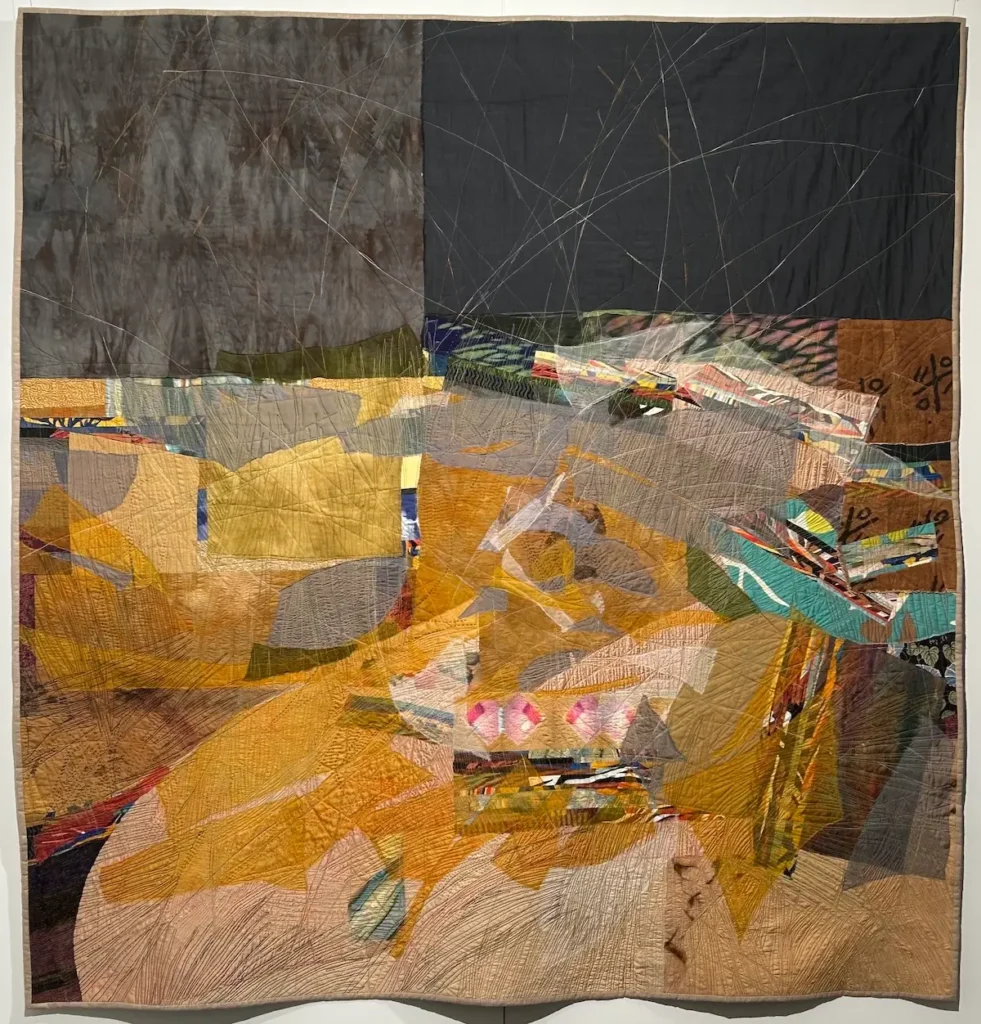
Tell us more about “quiltmakers way”.
I am sharing here the introduction to my book Adding Wood to the Fire: A Quiltmaker’s Way, where each chapter combines storytelling with the process of making a specific quilt.
“Not unlike other spiritual traditions, such as walking pilgrimage or silent meditation retreat, quiltmaking is a “way.” It has the ability to become underlying structure for a patchwork life that informs all of one’s work in the world. It can create context for experiencing all that one can be, moment by moment, stitch by stitch.
Every quilt has a story. I share life events through each telling. It’s not a timeline, but rather a chronicle of hopes and dreams interchangeable with challenges and realizations in a nonlinear way. In a playground of many teachers and no one master, this book is my testimony to an infinitely rich weaving of consciousness with countless moments spent in sacred space, with Love.”
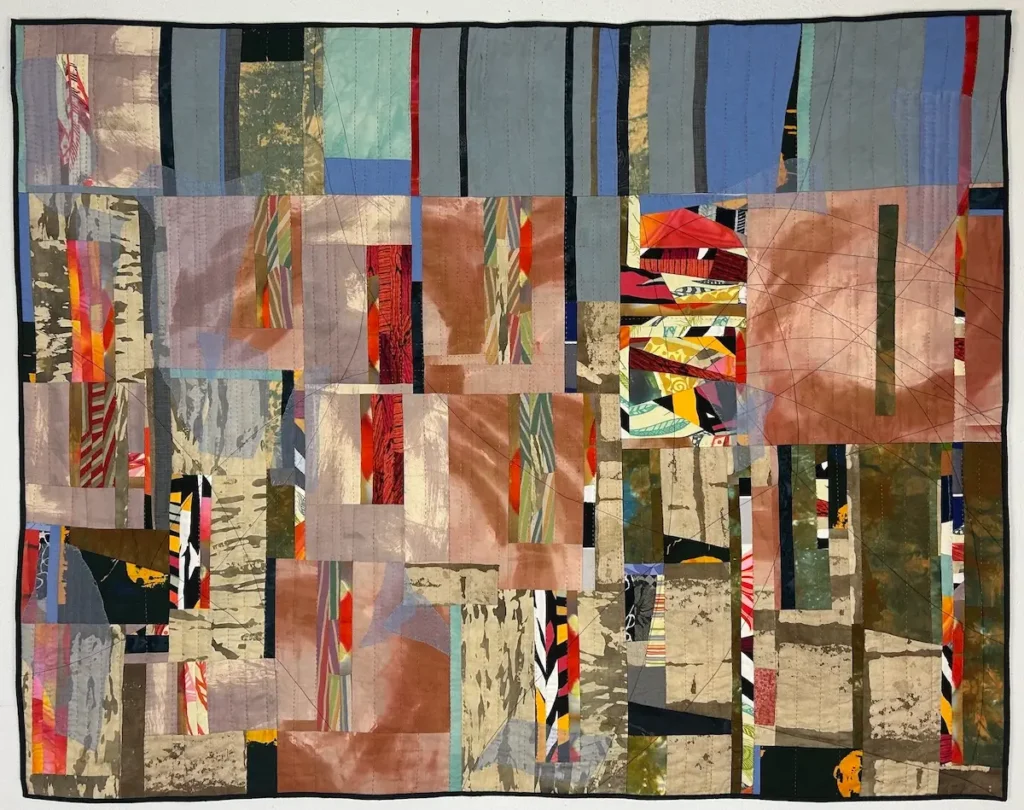
How do ideas of repair, reuse, or caring show up in your work and life?
Aside from the silk organza I buy to dye, I haven’t bought fabric in a long time.
I have an admirable stash from many years of collecting, but I find that now, it is from my scrap bins and/or a particularly enticing piece of clothing or cloth that has been gifted to me for reuse, that a palette for a new quilt comes from.
I’m reluctant to continue supporting both the textile and fashion industries in their extensive use of resources and eventual waste for production. These days, I choose to try to work my way through what I have, what I am gifted, or what I can salvage from going to a landfill.
I also collect abandoned knit clothing that gets cut, made into loops, and fashioned into ‘potholder’ rugs. Making these rugs is therapy, both in the reuse and in the fun process of making the potholders I loved to make as a child, even if now on a much bigger scale!
Do you think your quilts teach you something? If so, what was a lesson a recent quilt taught you?
Oh yes! They ALL teach me patience and to take the time each quilt wants to become what it is and not succumb to forcing my way through.
The quilt I am working on right now has recently taught me, again, that trying to impose or integrate an image that is too representational or specific just doesn’t work. I’ve come to accept that my work leans toward abstract expression and is most successful when I can capture the energy or essence of something rather than its specific image.

You use hand-dyed cloth, silk organza, and reclaimed fabric. How do those materials change the kinds of stories you can tell?
I have more freedom when working with a variety of cloth types. I value contrast and looking for how to fill a gap between two very different things. I find I take more risks and have more fun in the looking. As a result, the stories become deeper, richer, more layered, and more nuanced through these connections.
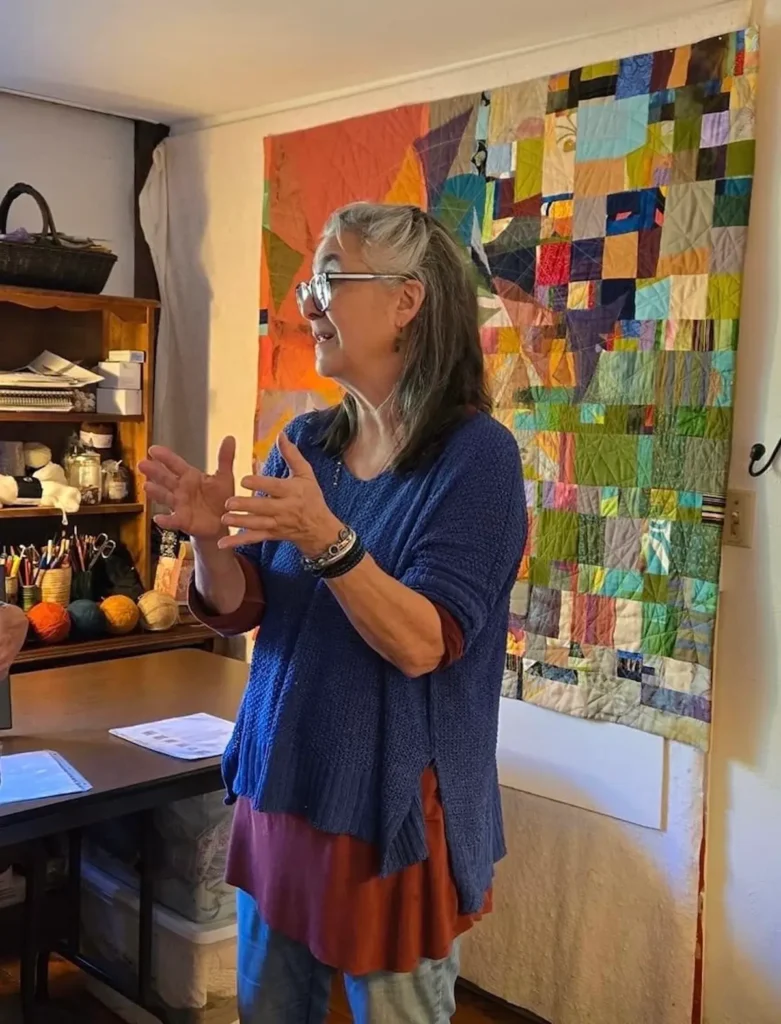
Describe your creative space.
My functional studio now occupies about a third of my home, three rooms on the ground floor of the original 28’ x 28’ historic house I live in, which also has a separate entrance.
These rooms open directly off of my kitchen, and I can see the largest design wall all day without having to enter the space. The quilting room is 14’ x 28’, with windows on three sides, three design walls, two large work tables with storage bins below, my expandable Bernini Q20 hydraulic table, and a fireplace!
I dedicate one room to weaving and knitting, and keep the in-between room free for display during studio tours and photographing as needed.

When you are choosing a scrap or a color, what tiny detail can make you pick it instantly?
For years, I would search out Marimeko fabrics for their big, bold designs and vibrant colors. It is this type of fabric that finds its way into all my quilts one way or another. Or a piece of periwinkle blue, which I will choose every time.
How do you balance planning (architecture habits) with letting the cloth surprise you?
With leap of faith, I will begin a process with the presupposition that order and beauty is there, and that I just have to be open to seeing it. I am consistently aware of the balance between structure and discovery in this improvisational way of working.

What gave you the courage to step into being a full-time maker?
There is a particular place on the path to a brook near my home, a very precise moment, when a ping ping ping in my body magically morphs into exquisite sensation. It feels like the tissue that occupies space between my heart and solar plexus is expanding. My breath catches.
It stops me in my tracks every time. It’s not always the exact same place when this happens, it’s like there is a clear line, not straight or identifiable by sight, that marks just where the edge of very old meets new, where what has always been meets what is always possible.
Seeking places where the possibility of movement from a ping ping ping to a heart opening presence has become a way of life. I think it is a gift to be able to have this experience and have come to believe it is my job to share it with others through my art.

What would you tell the younger Kathy who was deciding whether to make that leap?
I would tell her that the passion she felt making things as a child is the passion that will lead her to being a Creative in life, and it will be enough. But honestly, I’m not sure the younger Kathy would hear me.
Making the leap took a lot of personal growth work to be able to overcome the cultural conditioning that set me on a professional path in the first place.

What tiny daily habit keeps your creativity alive even on hard days?
I have a practice of randomly choosing a book, randomly opening to a page and with eyes closed, put my finger on a specific place. There is always a message to discern from what is there. Or I’ll randomly pick an oracle card, or randomly pick a piece of fabric from my scrap bin…
What part of your work feels most like care work — for yourself, for others, or for the planet?
Staying present to a full range of challenging feelings that will come up, especially when I am doing slow hand work, can lead to healing and acceptance. Caring for myself this way radiates to my loved ones and beyond.

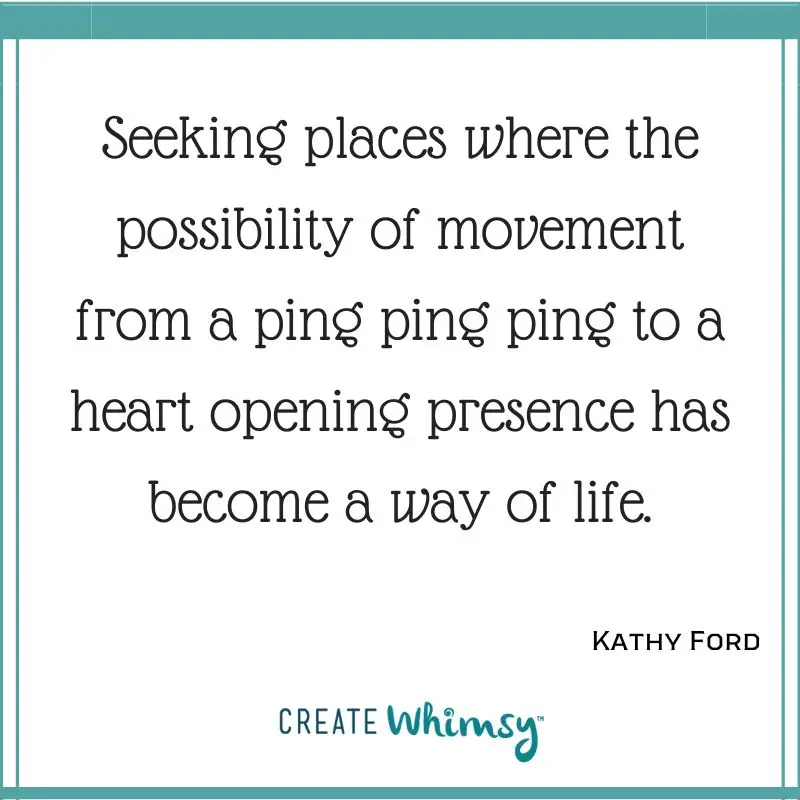
Where can people see your work?
I show my work at Oxbow Gallery in Easthampton MA, where I have a solo show coming up in May 2026. Pieces currently being shown in juried exhibitions are ‘Seen and Unseen’ in Quilt National ’25 and ‘Summer Reading’ in QAQ at the Schweinfurth Art Center this fall. I will participate in the Hilltown Open Studio Tour in October 2026, as I have for many years. I am also happy to receive visitors to my studio on request.
www.kathyford.net
Instagram: a.quiltmakers.way
https://oxbowartgallery.com
Interview posted September 2025
Browse through more inspiring art quilts on Create Whimsy.

